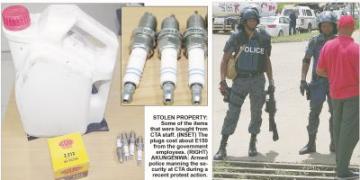CTA THEFT UNCOVERED

MBABANE – It’s a double headache for the Central Transport Administration (CTA).
About a month ago, the Minister of Finance, Neal Rijkenberg described CTA as a major drain to government coffers. Workers at the department are making it worse by selling car parts to members of the public, illegally.
Recently, the Times of Swaziland published a story that government assets at CTA, worth approximately E1 billion are protected by a knob stick (sagila).
Journalists from this publication, who recently went undercover, discovered how easy it was to purchase car parts from employees without triggering the wrath of the armed security guards.
During a two-week long investigation, our investigators were able to procure new car parts from two different depots of the agency.
Bought
The agency has depots in Mbabane (main branch), Matsapha, Nhlangano Siteki, and Pigg’s Peak.
The parts bought form part of a service kit which comprises power plugs, oil filter and five-litre magnetic oil.
In total these goods cost approximately E550 from a budget of E700. The plugs and oil filter were bought for E150 each while the oil cost E250.
There was an additional cost of E5 which was used to purchase a five litre container for the oil.
It should be noted that if a depot did not have a part, the buyer would be referred to another depot. The communication is done through cellphones.
In a nutshell, government is losing approximately E550 per day this translates to about E132 000 a year if this happens on a daily basis, which the CTA employee said was the case.
Loss
For argument sake, if there are 10 similar transactions each day, this means a loss of over E1 million a year.
This exercise proved to be costly because most of the parts were cheaper from legal retailers as per quotations sought.
The oil was the only cheap commodity as it retails at E380. The plugs and oil filter cost about E120 and E66, respectively.
When an explanation was sought about the ridiculous price, the response given was that a lot of people were involved. At most about four workers should be involved for the transaction to be smooth and undetected.
How the process starts - the buyer and seller or a middleman meet at drinking holes to discuss about the ‘project’. This is where the buyer would be informed if the parts he was intending to purchase were available on stock or not. He would then be told about the prices of each of the goods. Negotiations on the price list would then begin.




 del.icio.us
del.icio.us Digg
Digg
Comments (0 posted):